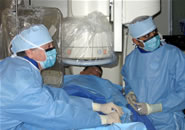| << To Blog Home >> | |
|
|
January 30, 2009 -- 9:50am EST Wrist Angioplasty Gaining Acceptance in U.S. A big question is why it isn't used more in the U.S. -- in Europe, Asia and South America it's done far more often (40-50% as opposed to 2%) than the "standard" femoral approach which uses an artery in the groin. One answer is training and interest. Traditionally cardiologists aren't trained to do radial procedures during their fellowships. Another is the perception that certain complex interventional procedures are more difficult to do via the wrist. But this may be changing. Yesterday Dr. John Coppola of St. Vincent's Hospital in New York held one of his radial courses -- and it did not need to be promoted, because it was filled to capacity even before being announced. Terumo Interventional, which makes equipment specifically for the radial technique, told me that all the training courses in the U.S. that they are involved in currently have a waiting list -- this certainly was not the case only a year ago. This past fall major meetings like TCT and ISET have been featuring symposia on the radial technique, and a recent article, "Radial-access PCI safe and successful in high-risk patients and complex lesions", published on theheart.org, generated far more online comments from cardiologists than the average story. And a recent study of 600,000 patients, published in JACC Interventions, showed a sharp uptick in radial procedures in the last quarter of 2007. (More current data is not yet available.) And the popular press has been reporting more as well: the CBS "Early Show" recently did a two-minute segment, with Dr. Howard Cohen sitting on a park bench showing catheters to host Julie Chen! So all of these movements are showing a gain for the wrist approach in the U.S. One big reason, of course, is that results show lower bleeding complications, and lower mortality with the wrist approach: a safer approach to both angioplasty and diagnostic cardiac catheterization. Support for these views can be found in the many peer-reviewed journal articles listed in the Reference and Bibliography section of Angioplasty.Org's Radial Access Center (now in its second year). But one such study, published in JACC back in 2005, recently was brought to my attention. A Stanford study of 3,500 consecutive patients undergoing angioplasty showed the incidence of retroperitoneal hematoma (RPH) at 0.74%. This is a very serious complication, where bleeding occurs at the femoral access site, but backwards into the large abdominal space in the body. It's often not recognized until well after the procedure and it can be very dangerous, resulting in serious blood loss, increasing morbidity and mortality. This means 1 in 135 patients will suffer this complication. And it was significantly more common in women. The radial approach virtually eliminates this complication. Stay tuned.... |
|


 Over
the past year,
Over
the past year,